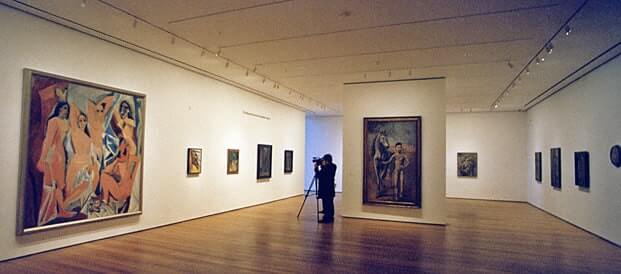The most well-known cubism painting is Les Demoiselles d’Avignon, which was created in 1907. Picasso rejected all recognizable traditional artistic form and representation in this painting. The concept that paintings will provide idealized images of female beauty is challenged by his unique use of deformation of the female body and geometric forms. It also demonstrates Picasso’s exposure to African art.
The creation of this huge picture took nine months. It exhibits Picasso’s passion’s true creativity and originality. To get ready for the finished piece, he produced a huge number of sketches and studies. According to several commentators, Henri Matisse’s Blue Nude and Le bonheur de vivre inspired the picture.
Later reviewers have extensively discussed its similarities to El Greco’s Opening of the Fifth Seal, Paul Cezanne’s The Large Bathers, and Gauguin’s Statue Oviri. The painting was viewed as immoral when it was initially displayed in 1916. Picasso had called the picture Le Bordel d’Avignon for nine years after it was finished, but art critic Andre Salmon, who oversaw its debut show, changed it Les Demoiselles d’Avignon to lessen its shocking impact on society. Salmon’s title was never Picasso’s favorite; as a compromise, he would have chosen las chicas de Avignon.
Leo Steinberg, a writer on art and literature, provided a completely original explanation for the wide range of expressive qualities in his 1972 piece “The Philosophical Brothel.” Using the earlier depictions, which most experts had ignored, he argued that the variety of styles can be seen as a conscious effort, a cautious arrangement, to attract the viewer’s attention rather than evidence of a craftsman going through a rapid expressive metamorphosis. He observes that the five women seem to be frighteningly unaware of one another and separated from one another. Instead, they focus solely on the audience, their divergent fashion choices just amplifying the intensity of their glare.
The idea of the self-possessed woman, no longer just there for the enjoyment of the male gaze, as well as the reversed gaze, or the fact that the figures look directly at the viewer, can both be attributed to Manet’s Olympia, 1863, according to Steinberg.
The attempt to record for this variety of styles inside the work has been the subject of much of the critical discussion that has taken place over the years. The prevailing interpretation for more than 50 years has been that it can be read as evidence of a transitional period in Picasso’s specialty, a push to associate his earlier work with Cubism, the style he would help design and grow over the course of the next five or six years. Alfred Barr, the first director of the Museum of Modern Art in New York City and coordinator of significant professional reviews for the craftsman, has embraced this interpretation most eminently.
On November 15, 1939, the Museum of Modern Art in New York City opened a significant Picasso exhibition, which was on display until January 7, 1940. The Art Institute of Chicago and Alfred H. Barr (1902–1981) collaborated to produce the exhibition, Picasso:40 Years of His Art. The important and then-newly painted Guernica and its studies, as well as Les Demoiselles d’Avignon, were among the 344 pieces that made up the exhibition.
5 Things You Should Know About the Masterpiece
1. After it was finished in 1907, Picasso kept “Les Demoiselles d’Avignon” in his Montmartre, Paris studio for many years because of the generally unfavorable responses of his close friends and colleagues. Despite a photograph of the piece appearing in The Architectural Record in 1910, the public only had the opportunity to see the painting in person in 1916 at the Salon d’Antin.
2. When Andre Breton reprinted the photograph and the essay titled “The Wild Men of Paris: Matisse, Picasso and Les Fauves” in the early 1920s, the art world only then began to accept the picture, a formative piece of Cubism by Picasso.
3. Picasso made hundreds of sketches, drawings, and paintings over the course of six months to prepare for the ultimate composition of “Les Demoiselles.” In terms of preparation for a single piece of art, he may have gone further than any other artist in history and worked harder than he ever had before.
4. Henri Matisse, a rival and coworker, reacted furiously when he saw Picasso’s artwork. Les Demoiselles, in Matisse’s opinion, was a critique of the modern art movement and took away attention from his own works Blue Nude and Le Bonheur de Vivre. He referred to the images in the painting as hideous whores.
5. The absence of perspective by the artist in “Les Demoiselles” is one factor in its innovative nature. There is nowhere for the eye to go beyond the women and their piercing looks; there is no vanishing point.



